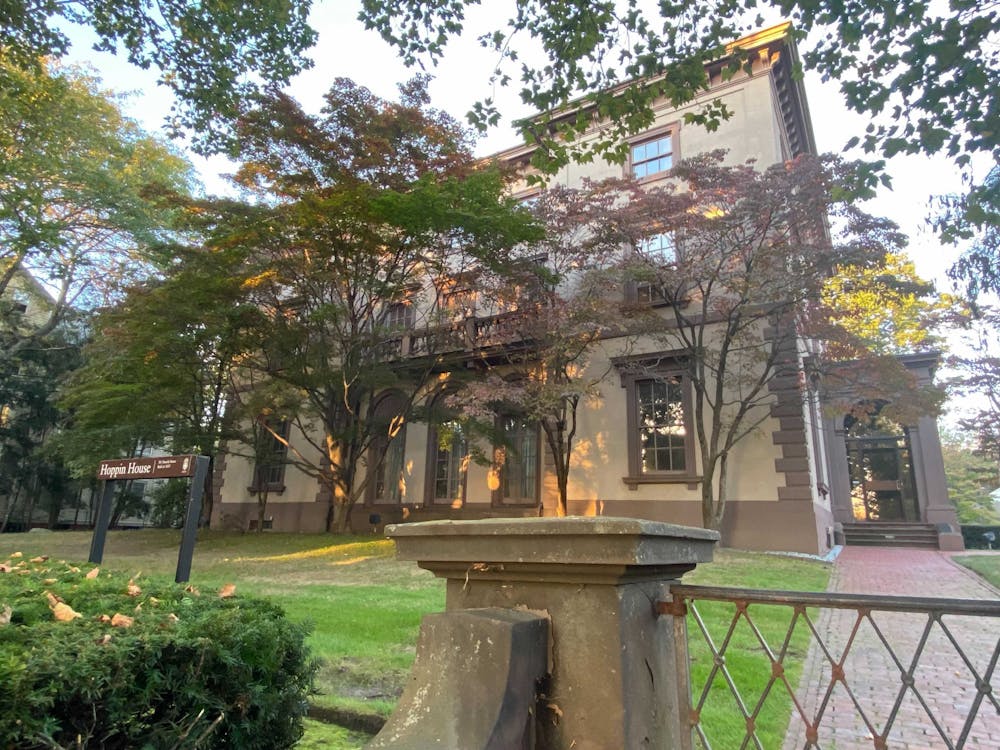The University sold Hoppin House, a mansion located on Benefit Street which sits on the National Register of Historic Places, for $2 million on Sept. 30, according to the Real Estate and Auxiliary Housing Office.
Standing three stories tall with 32 parking spots, the historic property — once home to the “richest woman in America” and, until recently, the Annenberg Institute — will become a luxury apartment building with six to eight units, said Rebecca Mayer, the agent for the buyers, Michael Holt Massey and his wife Sandra Ourusoff Massey.
Construction and design on the apartments has begun and will likely wrap up in the next 12 to 18 months. According to unreleased materials about the zoning change on the property, provided to The Herald by Michael Holt Massey, the renovations will take place within the “existing footprint” of the building and only make “minor exterior changes and necessary repairs” to the outside. Apartment prices, Mayer said, will be set in the luxury range of the market.
“The building itself is, from a campus perspective, in no-man’s land. It’s not in the Jewelry District or College Hill,” said John Luipold, vice president of real estate and strategic initiatives. After the Annenberg Institute moved in early 2019, the University found no short- or long-term use for the building, leading President Christina Paxson P’19 and the Corporation to approve putting the property on the market three years ago.
The property came close to selling before the onset of the COVID-19 pandemic, but uncertain economic winds led the buyer to back out, Luipold said.
While the University had hoped for “close to two-and-a-half (million dollars),” the price dropped in part due to the challenges of converting the building — which the University used for office space — into a residence. Still, the $2 million price tag is “one of the larger” property sales the University has ever made, Luipold added.
The process of selling to the Masseys took roughly half a year, Mayer and Luipold said. Part of that was an extensive 120-day period to investigate the property, according to Luipold.
Mayer said the Masseys also successfully applied for a zoning change to convert the former office space into a multi-family residence. That entailed a lengthy process to change the building’s zoning ordinance to an R-4 Residential District, which “accommodates higher-density residential development.” The University “participated and cooperated in important ways” to assist with that process as the owners of record at the time, Mayer said. She added that the Masseys also engaged neighborhood residents to allay concerns about how the change would impact the area, which includes the Providence Mile of History.
Following a presentation from the project’s architect, JP Couture, the Providence Preservation Society wrote a letter of endorsement for the zoning change, Michael Holt Massey wrote in an email to The Herald. The Providence City Council later unanimously approved the change, he said.
Advocating to transition an “abandoned institutional building that paid no taxes” into a “boutique luxury building” on the city’s tax rolls proved an easy sell for the couple’s zoning attorney, Patrick Dougherty, according to Michael Holt Massey.
“Although it took a fair amount of time to complete the rezoning process, we were pleased that it went so smoothly,” he wrote.
The zoning change, Mayer speculated, will not automatically set a precedent for multi-family zoning for other houses on Benefit Street.
“Changing the zoning on that property doesn’t change or improve the ability of someone else to do the same on a property that may or may not have the same merits or qualify in the same way this property does,” she said, noting the extensive footprint of the building at 16,536 square feet, and the lot at 35,463 square feet.
“When it comes to development and change, dramatic changes to a neighborhood often aren’t the best thing for it,” she said. “But I happen to feel that Benefit Street and Providence are extraordinarily lucky to have captured (Michael Holt) Massey’s attention. He’s putting the property back on its feet and holding on to his portfolio. There’s not many developers who take that approach.”
According to Mayer, the Masseys have experience in buying historically significant properties and renovating them in Newport and in the Beacon Hill neighborhood of Boston. They plan to hold on to the property, and rent out the apartments, she said. Michael Holt Massey added in his email to The Herald that the building will be the couple’s second on the National Register of Historic Places.
“We consider ourselves lucky to have the opportunity to restore this landmark architectural gem,” he wrote. “Although the expense of first-class renovations will limit the initial profitability, we expect that, years from now, our children will inherit a good (investment).”
“We’re very careful about who we sell our real estate to,” Luipold said, noting that the University often sells residential properties. “When we put a ‘for sale’ sign on a piece of real estate, we want to be sure this person is going to be a good steward of this property.” Hoppin House’s place on the National Register of Historic Places and the historic nature of Benefit Street, he added, only brought those concerns to the fore.
“I’ve been getting a lot of inquiries,” she added. “There does appear to be a huge demand for beautiful housing on the East Side for people who aren’t interested in purchasing but are looking for really nice rental options.”
The unreleased materials add that the project is focused on creating a “truly special environment for discerning residents and not simply filling the building with tenants.”
According to materials from the University, the mansion, designed for artist Thomas Frederic Hoppin and his wife, Anna Almy Jenkins, was built in 1853. Hoppin and Jenkins earned a reputation for hosting social events, leading the house to be dubbed “The House of a Thousand Candles” for its luminescent appearance inside and outside when the couple served as hosts. After Hoppin’s death, tenants included former Rhode Island Gov. George Wetmore, and at one point, President Rutherford B. Hayes was entertained in the house.
An architectural firm occupied the property for another six decades from 1920 on, before the University bought it in 1990. It then served as headquarters for the Office of Development, later as the home of the Office of Admissions and then as headquarters for the Annenberg Institute before it moved to 164 Angell St.
Director of the Annenberg Institute Susanna Loeb said that the move was part of a broader aim to embed the Annenberg Institute more fully in the University and make it more geographically accessible to students in order to increase engagement.
“We’re about as central as you can be,” Loeb said of the new location.
While Loeb did not lead the Annenberg Institute while it was in Hoppin House, she said that the building likely would have needed renovations to remain usable. And, she said, the Annenberg Institute is benefitting from a more modern office space.
“You see the old buildings on campus that have character, that’s a really nice aspect,” she said. “But for collaborating internally and bringing people in from around campus, (the Annenberg Institute) is in a great space right now.”

Will Kubzansky was the 133rd editor-in-chief and president of the Brown Daily Herald. Previously, he served as a University News editor overseeing the admission & financial aid and staff & student labor beats. In his free time, he plays the guitar and soccer — both poorly.





